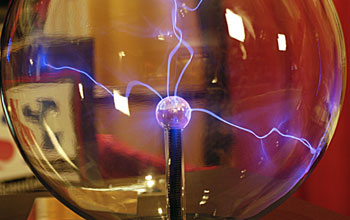Multimedia Gallery
Plasma ball at National Science Center exhibit
A plasma ball (also known as plasma sphere or plasma lamp), part of the National Science Center's exhibit at the Excellence in Science, Technology and Mathematics Education (ESTEME) Week "Expo 2004."
The ESTEME Week "Expo 2004" featured exhibits to promote excellent educational programs and best practices. Many exhibitors were nominated to participate, but the 29 "Best in the Nation" were invited to give a presentation during the expo.
The National Science Center's (NSC) Mobile Discovery Center was one of the 29 selected as "Best in the Nation." NSC's exhibit featured highlights from their national outreach programs, including hands-on interactive, high-technology exhibits like an artificial intelligence (AI) program, thermal image-visible light cameras, lightstick, plasma ball and website demonstrations. The NSC is a unique partnership between National Science Center, Inc., a nonprofit organization, and the U.S. Army. Formerly sponsored by the National Science Foundation, ESTEME Week is no longer an active program. (Date of Image: 2004)
More about this Image
Plasma lamps are usually a clear glass orb filled with a mixture of various gases at low pressure and driven by high-frequency alternating current at high voltage (approx. 35kHz, 2-5kV), and generated by a high-voltage transformer. A much smaller orb in its center serves as an electrode. Beams or snakes of "light" (actually emergent patterns in ionized gas) extend from the inner electrode to the outer glass container, giving an appearance similar to multiple constant beams of coloured lightning. The beams first follow the electric field lines of the dipole, but move up due to convection.
Placing a hand near the glass alters the high-frequency electric field, causing a single beam to snake around from the inner ball to the point of contact. An electric current is produced within any conductive object near the orb, as the glass doesn't block the flow of current when high frequencies are involved; the glass acts as the dielectric in a capacitor formed between the ionized gas and the hand.
Credit: Peter West, National Science Foundation
See other images like this on your iPhone or iPad download NSF Science Zone on the Apple App Store.
Images and other media in the National Science Foundation Multimedia Gallery are available for use in print and electronic material by NSF employees, members of the media, university staff, teachers and the general public. All media in the gallery are intended for personal, educational and nonprofit/non-commercial use only.
Images credited to the National Science Foundation, a federal agency, are in the public domain. The images were created by employees of the United States Government as part of their official duties or prepared by contractors as "works for hire" for NSF. You may freely use NSF-credited images and, at your discretion, credit NSF with a "Courtesy: National Science Foundation" notation.
Additional information about general usage can be found in Conditions.
Also Available:
Download the high-resolution JPG version of the image. (4.6 MB)
Use your mouse to right-click (Mac users may need to Ctrl-click) the link above and choose the option that will save the file or target to your computer.



